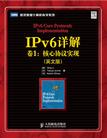IPv6详解
出版时间:2009-1 出版社:人民邮电出版社 作者:Qing Li,Tatuya Jinmei(神明达哉),Keiichi Shima(岛庆一) 页数:937
Tag标签:无
前言
Back in 1994.when the IETF accepted the proposal that iS known as IPv6 today,1 was convincedfrom that moment,such a new fundamental protocol would be difficult if not impossible to beaccepted,adopted and deployed by the networking community without a highqualiW opensource reference implementation that is freely available. This conviction stems from my close involvement with the original TCP/IPv4 protocolsand UC Berkeley’s BSD implementation of these protocols.I have seen firsthand how the BSDimplementation has made enormous contribution to the success of TCP/IPv4,commonly knownas the Internet protocols.We needed a new effort that played the same role for IPv6.It was our turn to make a contribution to the world of the Internet from a developer’s pointof view,but at that time the economic impact of the Internet boom already made my colleaguesat Berkeley too busy.I understood that we had a mission and SO the IPv6 working group wasborn in the WIDE project for this purpose,which eventually evolved into the KAME project.One of the requirements demanded of the so ftware to be developed by the KAWE project,was to demonstrate how the IPv6 protocols work and how well the protocols operate in realenvironments——a difficult and challenging task,With the long and very patient help from all thesupporters.the KAME project members fulfilled this goal with theft diligence and perseverance.The KAME implementation was adopted bv all major BSD variants as the defacto IPv6 implementation.And KAME iS often refefred to during IPv6 discussions at IETE meetings.I strongly believe the success of the KAME project played a significant role in the wide acceptance andthe continued adoption of the IPv6 technology.
内容概要
本书全面讲解IPv6及相关协议实现的事实标准KAME,揭示了KAME IPv6协议栈的所有细节,对每行代码到底做了什么,以及为什么要这样设计都进行了解释。全书共分6章,分别介绍IPv6单播路由选择协议、IPv6多播技术、IPv6的DNS DHCPv6、移动IPv6、IPv6与IP安全。书中每章都包含两个主要部分,第一部分是相关规范的综述,第二部分则逐行代码地描述和分析实际的实现。 本书是IPv6的权威参考书,适合网络设计和开发人员阅读。此外,本书还适合作为高校相关专业网络课程的教学参考书。
作者简介
Qing Li,系统公司资深架构师,负责领导下一代支持IPv6的安全代理应用系统的设计和开发工作。他曾在风河系统公司工作8年,是风河嵌入式IPv6产品的首席架构师:他拥有多项美国专利。并著有Real-Time Concepts forEmbedded Systems等畅销书。他还是FreeBSD操作系统项目活跃的开发者。
书籍目录
1 Introduction 1.1 Introduction 1.2 A Brief History of IPv6 and KAME 1.2.1 Commercial Success of KAME 1.3 Overview of the KAME Distribution 1.3.1 Source Tree Structure 1.3.2 Build Procedure 1.4 Overview of BSD Network Implementation 1.5 Source Code Narrations 1.5.1 Typographical Conventions 1.5.2 Sample Source Code Description 1.5.3 Preprocessor Variables 1.5.4 Networking Device and Architecture Assumptions 1.6 Mbufs and IPv6 1.6.1 Common Mbuf Manipulation Macros and Functions 1.6.2 Mbuf Tagging 1.6.3 Mbuf Requirement for IPv6 1.6.4 Diagnosing Mbuf Chain 2 IPv6 Addressing Architecture 2.1 Introduction 2.2 IPv6 Addresses 2.3 Textual Representation of IPv6 Addresses 2.4 Address Scopes 2.4.1 Scope Zones 2.4.2 Zone Indices 2.4.3 Textual Representation of Scoped Addresses 2.4.4 Deprecation of Unicast Site—local Addresses 2.5 IPv6 Address Format 2.5.1 Interface Identifier Generation 2.5.2 Notes about Address Format 2.5.3 Multicast Address Format 2.6 Node Address Requirements 2.7 IPv6 Address Space Management 2.8 Code Introduction 2.8.1 IPv6 Address Stmctures——in6 addr fl and Sockaddr in6 2.8.2 Macros and Variables 2.9 Handling Scope Zones 2.9.1 Initialization of Scope Zones 2.9.2 Scope Zone IDs 2.9.3 Zone IDs in Address Structures 2.9.4 Scope—Related Utility Functions 2.10 Interface Address Structures 2.10.1 ifaddr{}and in6_ifaddr{}Structures 2.10.2 in6_ifreq{)and in6_aliasreq{)Structures 2.10.3 Multicast Address Structures 2.11 IPv6 Prefix Structure 2.12 Overview of Address Manipulation Routines 2.13 Interface Initialization for IPv6 2.13.1 in6_if_up()Function 2.13.2 in6一ifattach()Function 2.13.3 in6一ifattach_loopback()Function 2.13.4 in6一ifattach_linklocal()Function 2.13.5 get_ifid()Function 2.13.6 get—hw—ifid()Function 2.13.7 get_rand_i fid()Function 2.13.8 in6if—do—dad()Function ……3 Internet Protocol version4 Internet Control Message Protocol for IPv65 Neihbor Discovery and Stateless Address Autoconfiguration6 Transport Layer Implications7 Socket API ExtensionsReferencesIndexAbout the Authors
章节摘录
插图:
媒体关注与评论
“阅读本书是一种享受,让我想起了RichardStevens的《TCPflP详解》,本书的技术深度完 全可以与之媲美,” ——Jim Bound,北美IPv6工作组主席 “在IPv6时代,本书将取代Richard Stevens的《TCP/IP详解》一书。我强烈推荐给所有程序员阅读:” ——Junichiro Hagino.KAME项目核心开发者
编辑推荐
IPv6的时代即将到来!《IPv6详解.卷1:核心协议实现》由开源的IPv6标准参考实现KAME的核心开发人员撰写,沿袭了被奉为经典的Richard Steverls的《TCP/IP详解》的写作方式和风格,覆盖了IPv6技术的全部内容,是毋庸置疑的IPv6权威参考书。书中详尽剖析了IPv6协议及其实现的技术细节,逐行诠释了KAME每一行代码的作用,并结合阐述了弥足珍贵的设计体会,对网络研究、设计和开发人员都有极高的参考价值。全书分为两卷,第1卷介绍核心协议的实现。第2卷主要介绍高级协议的实现。《IPv6详解.卷1:核心协议实现》适合网络设计和开发人员阅读,对于下一代网络产品研发人员尤其具有参考价值。Qin9 Li 8Iue Coat系统公司资深架构师,负责领导下一代支持IPv6的安全代理应用系统的设计和 开发工作:他曾在风河系统公司工作8年,是风河嵌入式IPv6产品的首席架构师:他拥有多项美国专利。并著有Real-Time Concepts forEmbedded Systems等畅销书。他还是FreeBSD操作系统项目活 跃的开发者: Tatuya Jinmei (神明达哉)东芝公司研究与开发中心的科学家。KAME项目核心开发人员。2003年在日本庆应义塾大学获得博士学位,Keiichi Shima(岛庆一)日本Internel lnitiative公司的资深研究人员。他的研究领域是IPv6和IPv6移动性。KAME项目核心开发人员,开发了移动IPv6/NEMO基本支持协议栈:现在正致力于BSD操作系统中新的移动栈(SHISA栈)的研究。
图书封面
图书标签Tags
无
评论、评分、阅读与下载
用户评论 (总计3条)
- 跟TCP/IP详解的风格差不多,非常不错。
- 8月14日下单,16日拿到书,快递还是可以的。拿到书后看了一下,书封面非常黑啊(可惜不能上传照片)。感觉是从煤炭里掏出来的。另外,书的纸张特别薄,对面的内容透过来,可能会有影响阅读。有点怀疑是否是正版。
- 这本书是沿用Richard Stenves经典的《TCP/IP Illustrated Volume 2: The Implementation》,在看这本书之前,花了2个星期看来一遍Stenves的经典书(买了8年了,一直没有看完,这次终于看完了,很有收获)。总体来说还行,基本讲清楚了FreeBSD下的IPv6 KAME实现。
KAME项目开始于1998年,最初是日本的几家公司想推动IPv6的发展,提供IPv6的参考实现,目前KAME IPv6已经集成到所有的*BSD项目,KAME本身也已经解散。(在FreeBSD 3、4百个commiter,来自日本的有50个左右,可见日本在Open Source方面还是有不少参与者~~)
书后面有个评论“在IPv6时代,本书将取代Richard Stevens的《TCP/IP详解》一书,我强烈推荐给所有程序员阅读”,未免言过其实。对于IPv6协议开发人员,本书有很大的价值,但对于系统管理员、IPv6使用者来说,意义不大,不适合入门使用。 我听了本书作者的一个访谈,基本上也是建议开发人员购买。
从我个人的感觉,IPv6大规模的商业化可能还有很长的时间,至少需要5~10年。IPv4的地址耗尽问题已经嚷了十几年来,从实际情况看,还远不是这么回事。当然,未雨绸缪,先了解IPv6总是好的,免得的时候措手不及。
